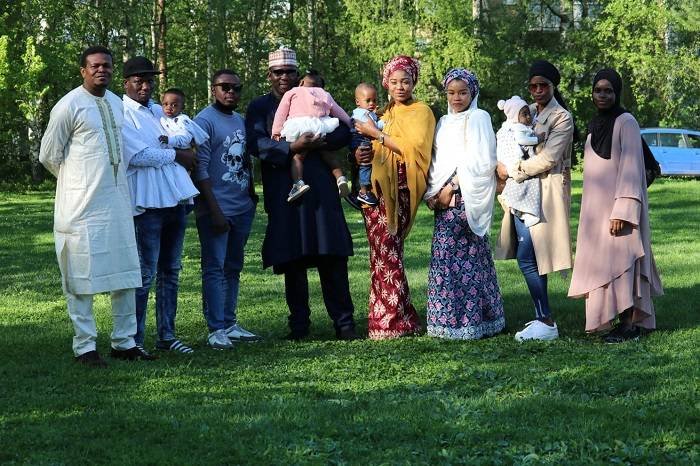Features
The Ghanaian Muslim community in Finland

Some Ghanaian muslims who are promoting Islam in Finland
Today, I focus on the Ghanaian Muslim community in Finland. As I have said previously, there are many personalities and institutions that contribute to the smooth running of things in the lives of Ghanaian migrants in Finland. The Ghanaian Muslim community is a very good example.
The exploits of such people or groups are laudable and should be acknowledged. I have previously written about the Church of Pentecost (COP) when their National Head, Apostle Eric Nyamekye, visited Helsinki a few months ago.
I have also written about the African Catholic Chaplaincy when Catholics, Lutherans and other worshippers celebrated a Thanksgiving Holy Mass organised by the Chaplaincy at the Kallio (Lutheran) Church in Helsinki, which was a key milestone in ecumenism.
The religious life of Ghanaian migrants in Finland, whether Christians or Muslims, also shows the role of religion in binding them together for positive outcomes.
The Ghanaian Muslim
community in Finland
There is a sizeable number of Ghanaian Muslims in Finland, although this estimation is based on my own rough evaluation and not on any official statistics. The Ghanaian Muslim group is a strong, well-knit one, devoted to building the spiritual and physical lives of its members through prayers at the mosque on Fridays and in other social activities.
The Muslim group has long been in existence. According to Mr Adam Mohammed Naporo, one of the founding members, most of the current members came to meet the group as a small community.
Initially, the members prayed with other nationals at their place of worship. Later, as the number of Ghanaian Muslims grew, they formed themselves into a well-organised group, which has existed for about 15 years now.
They also saw the need to educate the young ones about the Ghanaian culture and heritage. While teaching the tenets of the religion is seen as very important, “many parents felt the need to teach their kids the Ghanaian culture too, their roots”, Mr Naporo said.
Organising themselves
Aside going to the mosque for Friday prayers, the Ghanaian Muslims also organise other social activities that bring them together in unity and cordiality. These are goals that their leaders strive to pursue for the group to achieve.
The group usually gets together to celebrate important religious events such as the Eid ul-fitr and Eid ul-ahda. At such events, other people outside the group are invited to partake in the joyous celebration to mark the holy months of fasting.
The Muslim group also organises classes or a school (makaranta) for the kids every Saturday, Sunday, and on holidays. According to Mr Moro Abdulai, one of the leaders, the group also organises trips to Estonia and other places for its members.
Inculcating values
The new group got together a number of years back to raise their kids and teach them the tenets of Islam as well as values of the Ghanaian culture.
The leaders also try to instil discipline and give the kids the moral upbringing and identity as Muslims and as good citizens residing in Finland.
According to Mr. Abdulai, in their syllabus they also teach lessons on manners. Sometimes, they even invite experts within the Finnish society to talk and thus expose the kids with an education on discipline and integration.
How do they appreciate the Finnish society they live in? According to Mr Naporo, their group sees living as a kind of social contract. “We see ourselves as having a contract of living in Finland and so we should honour the contract by obeying the laws of the country. We let our people appreciate that”, he pointed out.
Unity and harmony
The Ghanaian Muslim community stands for unity and harmony in their group as well as in the larger Ghanaian migrant community in Finland.
The Ghanaian Muslims are very supportive of activities by the Ghana Union Finland, a body representing Ghanaian migrants and devoted to enhancing close cooperation and cordial relationships for effective integration of its members into the Finnish society, while also upholding the good image of Ghana abroad.
Members of the Ghanaian Muslim community prepare popular dishes—waakye, tuo zaafi, etc.—and donate them to the Ghana Union for its events, which are usually well attended.
Ensuring integration
All this also indicate the opportunities for members of the Ghanaian diaspora in Finland to integrate into the Finnish society through religion and their religious activities and affiliation.
As I keep pointing out, Finland encourages migrants’ participation in the planning of issues concerning the migrants themselves, using this strategy as one of the efficient ways to improve their inclusion. Thus, there is an enabling environment created within the Finnish religious ecology that undoubtedly helps migrants, including Ghanaian Muslim migrants, to integrate into the host Finnish society. Thank you!
Features
The Palestinian martyr-Little Hind Rajab
THE wickedness of some people in our world is gradually getting out of bounds. From local arena to international arena, reports of wicked acts that defies logic, is on the rise.
Russia has attacked Ukraine and as a result, the economies of many countries have been negatively impacted. Residential apartments which have no military purpose. Just sheer wickedness and cruelty.
After this came the Brutal attack on Gaza by the Israel Defence Forces. Hospitals were bombed, buildings were razed down and civilians were deliberately targeted which is a war crime according to the Geneva Convention.
The IDF will release pamphlets in the skies informing them to move to certain specified areas. They move there with their families only to be bombed again without warning.
It was one of such movement from one place to another that, the family of a 5 year Palestinian girl called Hind Rajab and her family, travelling in a vehicle, were shot at by an IDF Tank.
This wounded girl managed to call emergency services to come and save them.
The sad thing is that while this brave little girl kept talking to the emergency response person on the phone, telling them that they should come quickly and that she was afraid.
She further told the response team on phone that any time she tries to speak, blood comes into her mouth and it soils her dress and she dies not want her mum to scold her so they should come quickly.
The response team rushed as usual to her location but they were also shot and killed, the driver and his assistant, in a vehicle clearly marked as an ambulance. Ten days later when they got to her location, Hind Rajab and her family were dead and their vehicle was riddled with 335 bullets.
The wickedness with which the IDF waged the war against Hamas, the administrative authority in Gaza, was unbelievable, given the damage to civilians both collateral and in most cases deliberate.
There are reports of some Doctors from the US and other countries, who have described how children they attended to, who were brought in dead, had evidence of sniper bullets.
A report by one of the media platforms, indicated that one of the IDF snipers who died recently, had bragged about shooting children in the abdomen so they will suffer before dying.
What baffles me in all these atrocities, is why Jews who have been saved by a collective action of the world, from Hitler and his Nazis from destruction, infamously known as the Holocaust, is now visiting mayhem on others, namely the Palestinians.
One begins to wonder if Hitler was right after all and that he saw something that the rest of the world did not notice about the Jews. I must admit that it is not all Jews that are racist. It is the Zionist who are the problem with their Talmud which teaches that Jesus is burning in hot feaces.
They deliberately teach their children to hate other people who are not Jews especially the Palestinians. They do not consider the Palestinians as humans and therefore they believe they have the God given right to treat them anyway anyhow.
Hind Rajab’s death has pricked the conscience of the world and countries which used to blindly support Israel, are now putting pressure on them to observe a ceasefire as part of a peace negotiation.
Let the world through the UN show that it does not support barbarism and that the illegal occupation of Palestinian lands by Israel, must come to an end.
NB: ‘CHANGE KOTOKA INTERNATIONAL AIRPORT TO KOFI BAAKO INTERNATIONAL AIRPORT’
By Laud Kissi-Mensah
Features
Angioplasty: A comprehensive overview of the procedure and its applications
Angioplasty is a minimally invasive medical procedure used to widen narrowed or blocked arteries or blood vessels. The procedure involves the insertion of a catheter, a small tube, into the affected artery, followed by the inflation of a balloon to widen the artery. In some cases, a stent, a small mesh tube, may be placed to keep the artery open.
Indications for Angioplasty
Angioplasty is often used to treat conditions such as:
1. Coronary artery disease: Narrowing or blockage of the coronary arteries, which supply blood to the heart.
2. Peripheral artery disease: Narrowing or blockage of the arteries in the legs or arms.
3. Atherosclerosis: Buildup of plaque in the arteries, which can lead to narrowing or blockage.
The Angioplasty Procedure
The angioplasty procedure typically involves the following steps:
1. Preparation: The patient is given local anesthesia and may be sedated to help them relax.
2. Insertion of the catheter: A small incision is made in the skin, and a catheter is inserted into the affected artery.
3. Guidance: The catheter is guided to the affected area using imaging techniques such as fluoroscopy or angiography.
4. Inflation of the balloon: The balloon on the catheter is inflated to widen the artery.
5. Stent placement: A stent may be placed to keep the artery open.
6. Removal of the catheter: The catheter is removed, and the incision site is closed.
Benefits of Angioplasty
Angioplasty offers several benefits, including:
1. Improved blood flow: Angioplasty can help improve blood flow to the affected area, reducing symptoms such as chest pain or leg pain.
2. Minimally invasive: Angioplasty is a minimally invasive procedure, which means that it requires only a small incision and can reduce recovery time.
3. Reduced risk of complications: Angioplasty can reduce the risk of complications associated with more invasive surgical procedures.
Potential Risks and Complications
While angioplasty is generally a safe procedure, there are potential risks and complications, including:
1. Bleeding or hematoma: Bleeding or bruising at the incision site.
2. Artery damage: Damage to the artery during the procedure.
3. Restenosis: Narrowing or blockage of the artery again after the procedure.
Conclusion
Angioplasty is a highly effective procedure for treating narrowed or blocked arteries or blood vessels. While it carries some risks and complications, the benefits of improved blood flow and reduced symptoms make it a valuable treatment option for many patients.
References:
1. American Heart Association. (2020). Angioplasty and Stenting.
2. National Heart, Lung, and Blood Institute. (2020). Angioplasty and Stent Placement.
3. Mayo Clinic. (2020). Angioplasty: What You Need to Know.
4. Journal of the American College of Cardiology. (2019). Angioplasty and Stenting in Patients with Coronary Artery Disease.
This article provides a comprehensive overview of angioplasty, including its indications, procedure, benefits, and potential risks and complications.
By Robert Ekow Grimmond-Thompson
Join our WhatsApp Channel now!
https://whatsapp.com/channel/0029VbBElzjInlqHhl1aTU27






